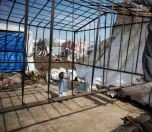Lebanon / © UNICEF/MENA 2014
According to the latest report of Save the Children and UNICEF shows that Syrian crisis and civil war trigger child labor day by day and more than three quarters of Syrian families’ children are working in order to contribute family budget.
Jordan
In Jordan, half of the Syrian child refugees contribute the family budget by working or being head of household. Three quarters of child refugees in Jordan stated they had health problems in workplace. 22% of the children are injured due to work accidents.
Lebanon
In some parts of Lebanon, children as young as six years old are reportedly working.
Trafficking of children
It was stated in the report that all working children are affected from armed conflict, sexual harassment of trafficking of human beings.
“The Syria crisis has dramatically reduced family livelihood opportunities and impoverished millions of households in the region, resulting in child labour reaching critical levels,” said Dr. Roger Hearn, Regional Director for Save the Children in the Middle East and Eurasia.
“As families become increasingly desperate, children are working primarily for their survival. Whether in Syria or neighboring countries, they are becoming main economic players.”
Hazardous environments
“Child labor hinders children’s growth and development as they toil for long hours with little pay, often in extremely hazardous and unhealthy environments,” said Dr. Peter Salama, UNICEF Regional Director for the Middle East and North Africa.
“Carrying heavy loads, being exposed to pesticides and toxic chemicals, and working long hours – these are just some of the hazards working children face every day around the region.”
Lost generation
Children who work are more likely to drop out of school – adding to fears of a “lost generation” of Syrian children.
Measures
UNICEF and Save the Children call on partners and champions of the No Lost Generation Initiative, the wider international community, host governments, and civil society to undertake a series of measures to address child labour inside Syria and in countries affected by the humanitarian crisis.
* Improve access to livelihoods including through making more funding available for income-generating activities
* Provide quality and safe education for all children impacted by the crisis
* Prioritize ending the worst forms of child labor
* Invest in strengthening national and community-based child protection systems and services.
2 million child refugees
According to UNICEF, there are 2 million child refugees outside Syria.
In Syria, the rate of unemployment was 14.9% in 2011, now it is 57.7%.
Before the Syrian civil war, almost all of the children were going school and the rate of literates was more than 90%.
It’s estimated today that 64.7% of Syrian people live in poverty and are lack of staple food and products. (YY/BD)
Click here to read this article in Turkish
We gathered this news from website of international non-governmental organization "Save the Children"







